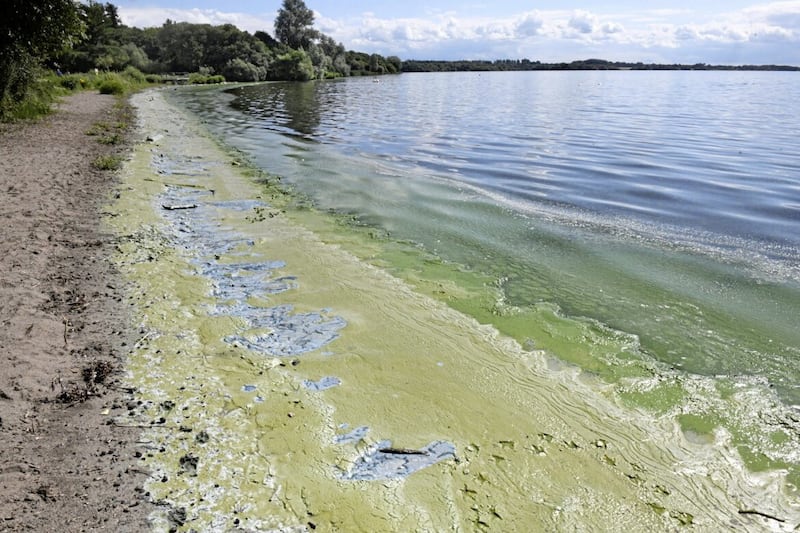If you look up Lough Neagh on Wikipedia – the font of all knowledge since we stopped buying encyclopaedias – it’s described as follows: "Lough Neagh is a freshwater lake in Northern Ireland and is the largest lake on the island of Ireland and in the United Kingdom."
This was true up until the fresh water began turning green due to a bloom of blue-green algae – when photographed from space, it’s hard to distinguish the lake from the surrounding green fields.
If we needed a metaphor for just how dysfunctional our wee statelet has become, then the putrid water of the Lough gives us one.
And the damage isn’t cosmetic: dog owners have been warned to keep their pets away and there have been reports of swan and fish kills along the lough shore.
Read more:
Fishing for world renowned Lough Neagh eels has collapsed: fishermen
Patricia MacBride: If we don't act now, we risk losing Lough Neagh's beauty forever
Friends of the Earth NI director, James Orr, gave this grim prognosis: “Lough Neagh is dying and it’s dying in plain sight,” continuing: “How an ecosystem that is so immense, so strategic, so beautiful, so rich in heritage has been ignored, forgotten and abused for decades is the story of wild west exploitation.”
When you consider 40 per cent of our drinking water is drawn from the Lough, the danger jumps from animals to humans, and you’d therefore presume a taskforce had been set up to deal with this impending catastrophe.
You’d be wrong. Due to our political paralysis, the usual mitigations haven’t even begun, and our part-time politicians unsurprisingly are yet again split on what action to take to deal with the escalating environmental catastrophe.
What’s to blame has yet to be identified but an educated guess would suggest a discharge of agricultural or human waste combined with decades of sand dredging, invasive zebra mussels, the effects of global warming with the temperature of the Lough’s water rising one degree Celsius since 1995, all creating perfect conditions for the algae to thrive.
While all these factors have contributed to the decline in water quality, a complete lack of centralised oversight remains a glaring issue.

Over two dozen separate organisations – from devolved government departments to local charities and councils – have responsibility for the Lough’s health, leading to a fragmented approach in protecting this national treasure.
Another problem is that the ownership of the soil, bed and banks of the Lough is held by the Shaftesbury estate. Originally a gift from King James to Sir Arthur Chichester during the plantation of Ulster in 1603, the ownership of the Lough passed to the Shaftesbury family in the 19th century.
That war plunder from the 17th century is still recognised as legal in the 21st century will appear ludicrously anachronistic to most people. In 2012, Sinn Féin's Francie Molloy questioned whether the Shaftesbury estate shouldn’t have liability for the condition of the Lough: "If you’re claiming ownership of it, then you have to take responsibility for it as well."
The present possessor of King James’s gift is 44-year-old Nicholas Ashley-Cooper, the 12th Earl of Shaftesbury, who recently acknowledged the risks posed to both human and animal health by the algae bloom.
Known for his philanthropic tendencies, these sadly don’t seem to stretch to Ireland as, instead of divesting his interest in the Lough for the good of all, the Earl is offering to sell his inherited ‘asset’.
Surely at the Lough’s moment of greatest need the multi-millionaire landlord could see his way to memorialise his family name in a positive fashion by helping to clean the waters, both literally and figuratively.
There is precedence for the state stepping in and limiting Shaftesbury’s ancestral claim. In the late 1960s and early 1970s, the estate attempted to claim ownership of the water at the Lough.
It charged the Belfast Water Commissioners – a body tasked with improving the city’s water supply – for extracting water. This claim was rebuffed by Stormont's then-ministers for agriculture and the environment who told a government meeting: "While the Shaftesbury Estate claims ownership of the water of Lough Neagh, this had never been accepted by the government."
If Shaftesbury refuses to do the decent thing, then his family name will be added to the long list of British aristocracy who’ve used Ireland as nothing more than an inherited money bank.
While he won’t be able to smell the decay of Lough Neagh from his English ancestral home, St Giles House in East Dorset, he can rest assured the stench of its death will cling to his family’s name forever.








